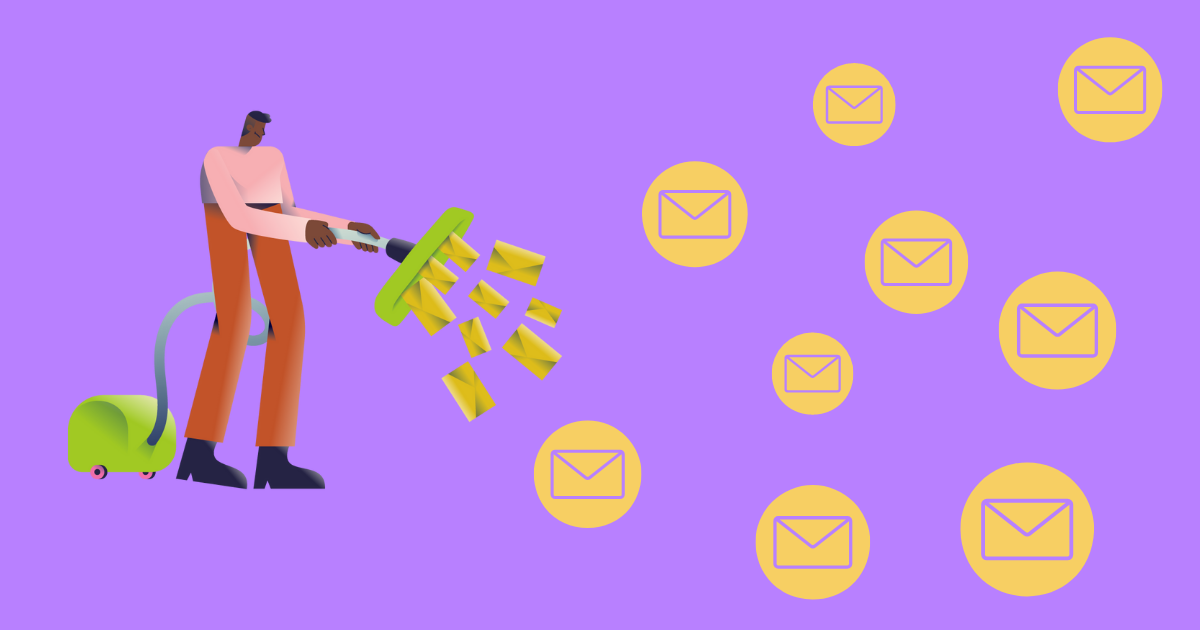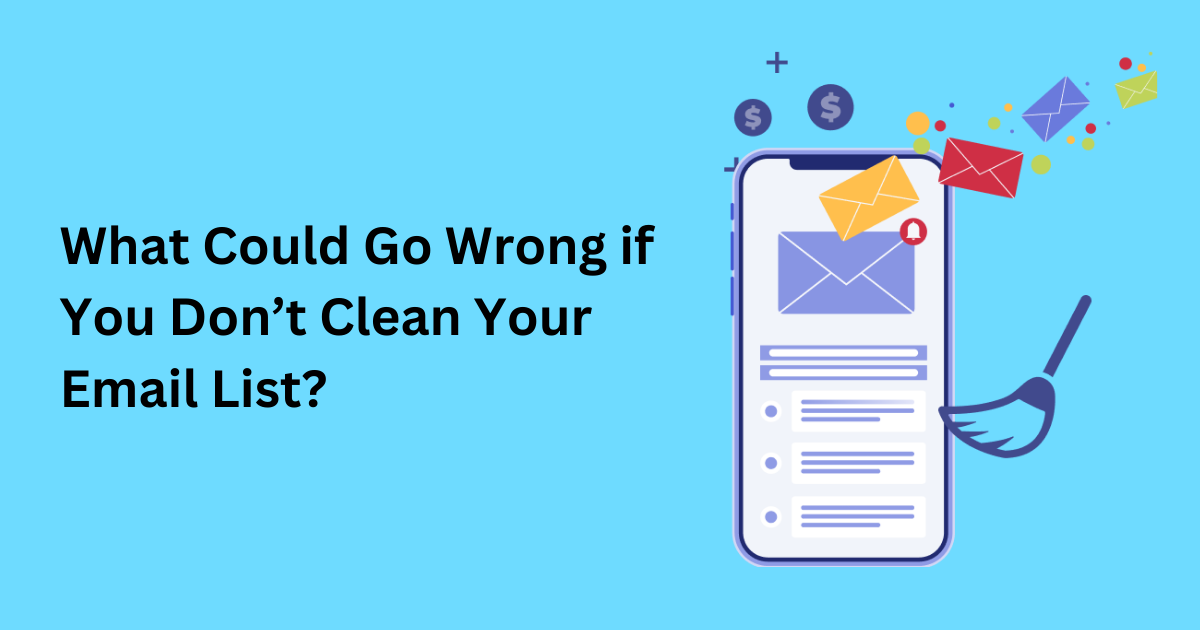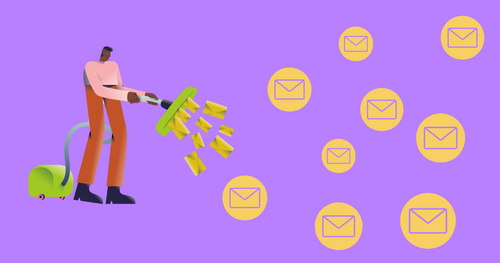When you purchase an email list, it can be tempting to jump right in and start sending out your mass email marketing campaigns. You don’t know if the email addresses are valid, if the people on the list actually want to hear from you, or if you’re just wasting your time.
If you’re like most people with an email list, it’s probably full of inactive subscribers. This can lead to a lot of wasted time and marketing efforts trying to reach leads that are no longer interested.
But don’t worry, there are ways to clean your list and make sure it’s full of engaged subscribers who are excited to hear from you. Because doing so will make sure you’re only engaging with the most accurate and up-to-date subscribers
This can help you save time and improve your chances of success when reaching out to customers. In this guide, we will go over email cleaning best practices and services you can use to clean up your email list and improve your overall email marketing strategy.
What’s the Purpose of Cleaning an Email List?

Cleaning an email list is the process of removing inactive email addresses from a list of contacts. There are several reasons why it’s important to clean an email list on a regular basis:
- To improve deliverability rates: If you have a large number of invalid or duplicate email addresses on your list, your emails are less likely to be delivered to the actual people who signed up to receive them. This can damage your sender reputation and make it more difficult (and more expensive) to reach your audience.
- To avoid being marked as spam: Email service providers flag accounts that send emails to large numbers of invalid or inactive addresses as potential spammers. This can result in your emails being automatically filtered into recipients’ spam folders, making it even harder for people to see them.
- Better segmentation: Cleaning your email list also allows you to segment your subscribers more effectively, and get better results from your email marketing campaigns by sending highly targeted emails to smaller groups of people who are more likely to be interested in the content.
Not only does this improve the chances that people will actually read and click through on the links in our emails, but it also helps to keep your list clean.
What Could Go Wrong if You Don’t Clean Your Email List?

Having a robust email marketing strategy built out is always a good marketing practice, it allows you to stay in touch with your customers and prospects, build relationships with them, perform hyper-targeted strategies through segmentation, and much more.
However, if half of your list contains outdated email addresses and you’re not taking email list cleaning seriously, it can become a liability.
Your email deliverability will suffer if you have a lot of invalid or stale email addresses on your list. Your messages will either get bounced back or end up in the spam folder. Either way, your recipients will never see them.
Additionally, having a lot of deadweight on your list full of unengaged subscribers will make it harder for you to create targeted campaigns. Your emails will be less relevant and personal, and as a result, your open and click-through rates will suffer.
The bottom line is that if you want to keep your email list healthy and effective, you need to clean it regularly and follow the best email list cleaning practices that we’re revealing today.
5 More Big Risks of Not Cleaning Your Email List.
1) Damage your IP reputation
An email list’s reputation can be damaged in a number of ways. The most common is poor list management and lack of email list cleaning. This can lead to your emails being marked as spam, which can damage your sender’s reputation and make it difficult to deliver emails to inboxes and reach email subscribers.
To avoid this, it’s important to keep your email lists clean and up-to-date. Remove inactive subscribers, and bounce back addresses.
This will help ensure that your emails are reaching the right people and that your sender’s reputation remains intact, thus fewer spam complaints.
2) Harm your deliverability rates
If you’re someone who relies heavily on email marketing to drive business to your website but you struggle with a bad deliverability rate, then you know how frustrating it can be to see your hard work go to waste.
A low deliverability rate can be caused by a number of factors, but the most common culprit is an uncleaned email list that ultimately results in disengaged subscribers.
Cleaning your email list is essential if you want to improve your deliverability rate and reduce hard bounces So, If you’re serious about improving your email marketing results, then cleaning your list should be one of your top priorities. email list cleaning tools can help you get rid of invalid subscribers and get one step closer to achieving your goals.
3) Wasted money on email marketing
Most email marketing platforms such as MailChimp charge you depending on the number of contacts that you are sending emails. While a few invalid email addresses won’t cost a lot, high-volume email bounces can add up quickly and hurt your marketing budget tremendously. MailChimp will automatically reduce the number of hard bounces, but won’t necessarily remove any soft bounced emails until they bounce at least 7 times.
The point is, by regularly cleaning your email list from invalid email addresses you can make sure that you’re not spending unnecessary advertising money on things that don’t matter.
4) Increase in spam complaints
If you’ve been noticing an increase in the number of spam complaints from your email list, then it’s time to take a closer look at who exactly is on that list. A clean email list is essential for any company that relies on email marketing – and that should be all of them.
There are a number of ways to clean your email list, but the most important thing is to make sure you’re only sending emails to people who have actually signed up to receive them. That means removing any addresses that have been added without permission, as well as any that are no longer active.
Inactive addresses can be a major source of spam complaints, so it’s important to remove them from your list on a regular basis. You can do this manually or with the help of an email list cleaning tool. but either way, it’s crucial for keeping your complaint rate low.
5) High unsubscribe rate
An uncleaned email list is one of the main reasons for a high unsubscribe rate. When people sign up for your emails, they expect to receive timely, relevant, and highly tailored messages from you. If they instead receive a string of irrelevant or broadly general emails, they’re likely to unsubscribe.
One way to keep your unsubscribe rate low is to regularly clean your email list. This means removing people who have bounced, who have marked your emails as spam, or who haven’t engaged with your emails in a long time. Keeping your list clean will help ensure that only people who are interested in hearing from you are on it.
If you’re seeing a high unsubscribe rate, take a look at your email list and see if it needs to be cleaned up. A little bit of maintenance can go a long way towards keeping your subscribers happy and engaged.
6) Increase in bounce rate
Email bounce rates are one of the most important factors to consider when trying to keep a clean email list. A high email bounce rate can indicate several problems, all of which can lead to your emails being undeliverable.
There are a few different things that can cause a high email bounce rate. The first is having an outdated or invalid email list. If you’re using an old list that hasn’t been cleaned in a while, it’s likely that some of the addresses on it are no longer valid. This can happen for a number of reasons, such as people changing jobs or switching email providers.
What Causes a Dirty Email List?

1) Changed server provider
Take an example in which a person first uses a local email service provider before migrating to Gmail or Hotmail. In certain instances, the recipient will not get your emails, even though the older ones could still be active.
2) Switching positions within a company
Depending on their position, each employee will have a different email address. Employees in the C-suite, mid-levels, and junior ranks use different email address formats. Your email messages may bounce when someone is promoted from a junior to a mid-level position since their email address is no longer functional.
3) Changed job entirely
People frequently change jobs, and when they do, emails may be forwarded to another person or become unreachable.
4) Duplicated email addresses
One of the main reasons an email list may be invalid is because of duplicate email addresses.
There are a few ways that duplicate email addresses can end up on an email list. Maybe someone accidentally entered their email address twice when signing up for something. Or, perhaps someone mistyped their email address and it ended up being slightly different than what they originally intended.
Whatever the reason, duplicate email addresses can cause major problems for an email marketing campaign. That’s because if someone receives multiple emails from the same sender, they’re likely to either unsubscribe or mark the emails as spam. Either way, it hurts the chances of the campaign being successful.
The good news is that there are ways to clean up an email list and get rid of any duplicate entries. including using a reliable email cleaning service such as Email List Validation
When Should You Consider Cleaning Your Email List?
It’s important to keep your email list clean and up-to-date, but how often should you do it?
The frequency of cleaning your email list depends on a few factors, such as the size of your list and the number of emails you send out. A good rule of thumb is to clean your list every six months.
However, if you have a large list or send out a lot of emails, you may need to clean it more often. You can use an email validation service to help you keep your list clean.
An email validation service can also help keep your list clean and up-to-date. By verifying each email address on your list, you can be sure that the addresses are still active and that the people on your list still want to receive your messages. This can save you time and money in the long run by avoiding bounced messages and unsubscribe requests.
Things You Should Do Before You Start Email List Cleaning
Email list cleaning can be a time-consuming process, but it’s worth it if you want to improve your email deliverability. But, there are a few things you should do before starting your email cleaning process.
Keep these tips in mind and you’ll be on your way to a cleaner, more engaged email list in no time!
Monitor Soft and Hard Bounces
Before you start cleaning your email list, it’s important to monitor soft and hard bounces.
A soft bounce is an email that’s returned because the recipient’s mailbox is full or the server is temporarily unavailable. A hard bounce is an email that’s returned because the recipient’s address is invalid.
If you have a lot of soft bounces, it could be a sign that your emails are going to spam folders. To avoid this, you can try using a different sender name or address. If you have a lot of hard bounces, it means that there are invalid addresses on your list. You’ll need to remove these addresses before you continue sending emails.
Launch a Re-Engagement Email Campaign
If you’re looking to improve engagement with your email list, one great way to start is by launching a re-engagement campaign. Here are a few tips to get you started:
- Start by taking a close look at your email list and identifying any inactive subscribers.
- Once you’ve identified who your inactive subscribers are, reach out to them with a special offer or piece of content that will incentivize them to re-engage with your brand.
- Make sure to track the results of your campaign so that you can continue to optimize and improve your results over time.
By following these simple tips, you can launch a successful re-engagement campaign that will help get your inactive subscribers back engaged with your brand.
Best Email List Cleaning Practices in 2022
Start Segmenting Your Subscribers.
Email list segmentation is one of the most important things you can do to improve your email marketing. By segmenting your subscribers, you can send more targeted and relevant emails that will improve your open and click-through rates.
There are a few different ways you can segment your subscribers. One way is by their location. This is especially useful if you have a brick-and-mortar store or if you offer different products or services in different regions.
Another way to segment your subscribers is by their purchase history. This allows you to send targeted emails with special offers and discounts for products they’ve shown an interest in.
Finally, you can also segment your subscribers by their engagement levels. This means sending different emails to those who frequently open and click through your emails, versus those who never open them or only occasionally engage with your content.
Remove Any Duplicate Emails
If your email list is loaded with duplicates, it’s time to do some cleaning. Duplicate emails can cause a number of problems, including decreased deliverability, higher bounce rates, and wasted resources.
Cleaning your email list is fairly simple and only takes a few minutes. Start by exporting your list into a CSV file. Then, use an email cleaning tool such as Email List Validation to remove any duplicate entries. Finally, import the cleaned list back into your email marketing platform.
By removing duplicate emails from your list, you can improve your deliverability, avoid wasting resources and keep your bounce rates low. So take a few minutes to clean up your list and ensure that your emails are reaching their intended recipients.
Provide an “Opt Down” Option
Opt-down options provide a way for subscribers to tell you they no longer want to receive emails from you. This can be done through a preference center, where they can choose to receive fewer emails, or through an unsubscribe link included in each email.
An opt-down option is a great way to keep your list clean and improve your deliverability. It also shows that you respect your subscribers’ wishes and are willing to work with them to ensure they only receive the content they want.
Remove inactive subscribers
Inactive subscribers are those who haven’t opened or clicked on an email in a long time.
There are a few reasons why you would want to remove inactive subscribers from your list. First, it’s good for deliverability. The more inactive subscribers you have, the more likely your emails are to end up in spam folders.
Second, it’s a way to keep your list clean and focused. You don’t want to be sending emails to people who aren’t interested in hearing from you. It’s a waste of time and resources.
Finally, it can help you get a better sense of your true engagement rate. If you have a high number of inactive subscribers, it can skew your metrics and make it difficult to see how well your emails are actually performing.
Key Takeaways
After you have cleaned your email list, it is important to monitor your results and make sure that your deliverability does not suffer. You can do this by keeping an eye on your unsubscribe rate and complaint rate. If you see a significant increase in either of these, it may be time to consider another email list cleaning service.
Frequently Asked Questions:
1. How do I clean up my email list?
Email lists can get cluttered over time with inactive subscribers, typos, and bounces. Keeping your email list clean can improve deliverability and prevent your emails from being marked as spam. Here are some tips for cleaning up your email list:
- . Remove inactive subscribers: If someone hasn’t opened one of your emails in 6 months, they’re probably not interested in hearing from you anymore. Send them a re-engagement campaign and if they don’t respond, remove them from your list.
- Remove typos and bounced emails: These are invalid addresses that will never reach their intended recipient. Removing them from your list will improve deliverability and prevent your emails from being marked as spam.
- Keep an updated unsubscribe link: This will allow people who no longer want to receive your emails to easily unsubscribe.
- How much does it cost to clean an email list?
The cost of cleaning an email list varies depending on the size of the list and the method used to clean it.
The most common way to clean an email list is to use a paid service. These services typically charge a flat fee or a per-email rate. The cost of these services can range from $50 to $500, depending on the size of the list and the features offered.
For businesses with large email lists, it may be more cost-effective to contact the software sales department to negotiate an enterprise package.
2. How can I clean up my email list for free?
If you’re on a tight budget and you’re looking for a free way to clean your email list then there is a free way to do that and that’s by doing it manually, without using any third-party tool.
It can be time-consuming, but it’s as effective as a paid tool. First, take a look at your email list and see if there are any old or inactive addresses. These can be removed from your list to make it more manageable. Secondly, take a look at the bounced emails on your list. These are addresses that have been invalidated or no longer exist. You can either remove them from your list or try to update the email address.
Finally, consider segmenting your email list into different groups based on interests or demographics. This will allow you to send more targeted emails that are more likely to be opened and read by recipients. By taking these steps, you can clean up your email list and make it more manageable without spending any money.
3. How often should I clean up my email list?
How often you clean your list really depends on a few factors: how frequently your contacts engage with your emails, how old your list is, and if you’re consistently acquiring new subscribers.
If you have a high volume of subscribers and low engagement, you may want to consider cleaning your list more frequently. If you have a smaller list or higher engagement rates, you can afford to clean it less often. And if you’re regularly acquiring new subscribers, it’s less critical to clean up your entire list as often because you’re constantly adding fresh contacts.
Generally speaking, we recommend running an email list cleanup at least once per quarter. But again, it all depends on the health of your database and how frequently your contacts are engaging with your emails.



